Ngā kōrero ohumahi o tō mātou rohe – Our region’s workforce story
On this page
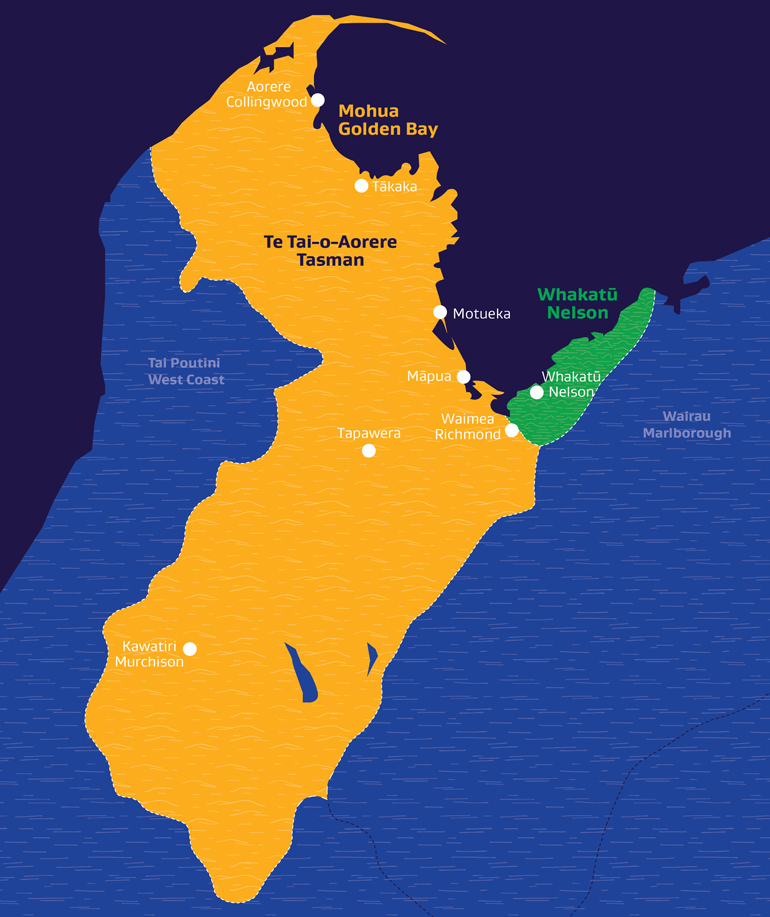
Text description of map
We are diverse, innovative, and rich in history
In 2021, Nelson Tasman was home to 112,600 people. Approximately 72,000 (60%) of these were of traditional working age (15-64 years old). 1 person in 5 of our broader regional population was born overseas, meaning we have strong connections to the rest of the world. Statistics NZ projections are that by 2048 only 51% of our people will be of traditional working age.
Together with Marlborough, Nelson Tasman makes up the rohe of Te Tauihu.
The 8 tribes of Te Tauihu are:
- Ngāti Kuia, Rangitāne o Wairau, and Ngāti Apa (Kurahaupō waka)
- Ngāti Koata, Ngāti Rārua, and Ngāti Toa (Tainui waka)
- Ngāti Tama and Te Āti Awa (Tokomaru waka).
Population at a glance, Nelson Tasman Regional Economic Profile(external link) — Infometrics
Our Māori population as a percentage of our total Nelson Tasman population is projected to grow from 11% to 15% in Nelson and from 9% to 12% in Tasman by 2043.
Māori population share projected to grow in all regions(external link) — Stats.govt.nz
As a region, we have already done a lot of planning for the future we want to create
The Te Tauihu Intergenerational Strategy (TTIS) was published in 2020. It was developed over two years, guided by extensive community consultation and input.
The TTIS outlines a vision: tūpuna pono, to be good ancestors. It places the oranga Te Tauihu at its heart – the wellbeing of our people and our places over generations. The strategy has eight ‘intergenerational outcomes’ at its core, from te taio (the natural world) and pūtea (economy), to te tauihutanga (top of the south identity) and mātauranga (knowledge). There are 17 actions identified in the strategy to achieve its outcomes.
Te Tauihu website(external link)
The Te Tauihi Intergenerational Strategy
Te Taiao – Environment: Our relationship with the natural world is healthy.
Pūtea – Economy: Our resilient economy allows our people, places, communities, and businesses to thrive.
Te Tauihutanga – Identity: Our people are proud of their individual and shared identity and feel a strong sense of belonging. We treat each other with kindness and respect.
Whānau – Community: Our people and communities are welcoming, healthy and safe. Our people are connected across generations, cultures and distance.
Te Rākau Taumatua – Place: Our people can access affordable and quality places to live. Our shared spaces are places where people want to be.
Manaakitanga – Leadership: Our decision-making is collaborative, courageous, inclusive, respectful and acts for the long term. We uphold the values and rights of the people and taonga of our region.
Papa Whenua – Infrastructure: Our people have resilient transport, communication and energy networks, and water and waste systems.
Mātauranga – Knowledge: Our people are knowledgeable, curious and creative.
We have also put extensive thought into implementing the TTIS in Nelson Tasman, and the opportunities and challenges for our region. This work is outlined in the consultation document Nelson Tasman Regeneration Plan 2020-2031 (Project Kōkiri 2.0) and includes the snapshot below.
Nelson Tasman regeneration plan 2021 - 2031 [PDF 11.9MB](external link)
A snapshot of challenges
Global challenges
Issues
- Climate change
- Inequality and global poverty
- Exhaustion of non-renewable resources
Local impact
- Nelson Tasman is vulnerable to sea level rise
- Nelson Tasman has signifcant material hardship and child poverty
- Nelson Tasman is reliant on natural resources for our economic prosperity
New Zealand challenges
Issues
- Low productivity
- Low wages
- Skills shortages
- A lack of diversifcation
- Under-investment in infrastructure
- A rapidly ageing population
- Housing affordability and access
- Shallow domestic capital markets
- Biodiversity decline
Local impact
- We have a number of skills shortages and seasonal labour challenges
- We are an export driven economy, vulnerable to global conditions
- We have a relatively low and ageing population base with signifcant growing pressures which makes it diffcult to fund infrastructure
- We are on track to have the fastest growing ageing population in the country and our working age population is declining, in contrast to the national trend
- We have the third worst housing affordability in NZ (average house price divided by average household income) with a lag in supply we have been carrying for over a decade
- Our capital fow tends to favour real estate over commercial or innovation opportunities
- Changes in land and sea use, climate change, pollution and invasive species are putting pressure on te taiao
Regional challenges
Issues
- Distance
- Scale
- Complacency
- Perception
Local impact
- We are still facing signifcant disruption as a result of COVID-19 including supply chain and labour market issues
- We are heavily reliant on our port and airport, with a relatively small “surrounding” population within driving distance
- We are a small region spread across a large geographical area which makes infrastructure challenging to fund and deliver
- Our unique lifestyle offering and relaxed culture tends to fuel complacency
- We are often seen as “sunny nelson” free of any issues which hinders the attraction of public sector investment, and for prospective skilled workers we have a reputation for “sunshine wages”
We are a hands-on workforce, predominantly involved in primary industry and manual jobs
In 2021 there were 57,000 filled jobs across the region (unless otherwise stated, all data is sourced from the Nelson Tasman Economic Briefing prepared for the NRDA by Benje Patterson, People and Places, February 2022; unpublished). The primary sector is the largest industry employer, with agriculture, horticulture, forestry, and fishing providing 11.4% of the region’s jobs. The primary sector is a highly seasonal industry, which creates significant challenges for people working in this sector to attain consistent work and income. Seasonal work affects their ability to access rental properties and home loans.
Manufacturing employs 11.2% of workers, and is the second-largest employing sector, often processing our primary products.
Both sectors provide many manual jobs, employing people as labourers in forestry, farms, and factories. These are also the largest employing sectors for Māori – 12.4% and 11.6% respectively.
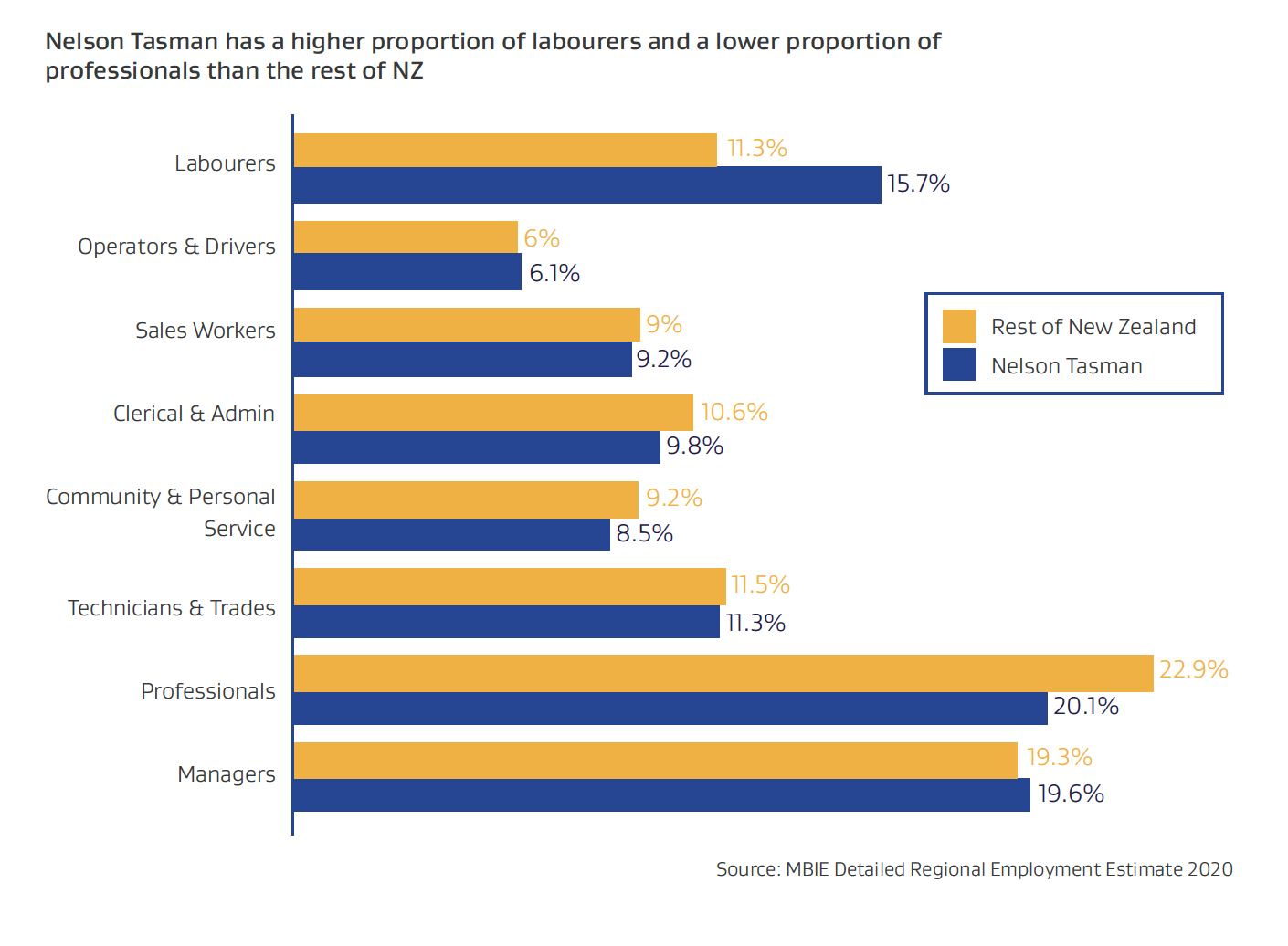
Text description of graph
(external link)Our economy has few large businesses and many small to medium enterprises (SME)
We have over 13,000 businesses in Nelson Tasman, and almost all of these are small to medium-sized. Most of our businesses are small, with 91% employing fewer than 10 people, 7.3% employing between 10 and 49 people, and just 1.3% having more than 50 employees.
More than 10,000 people in the Nelson Tasman region are self-employed (18.3% of people employed, in comparison to 16.7% nationally). These people mostly work in construction, professional, scientific and support services, and agriculture, forestry, and fishing.
Self-employment by ANZSIC 2021 Nelson Tasman(external link) — Infometrics
Across Te Tauihu there are approximately 500 self-employed Māori and at least 156 Māori-owned businesses.
The region’s largest employers as individual businesses, rather than by sector, include the Nelson Marlborough District Health Board; Nelson Marlborough Institute of Technology; Nelson Pine Industries Ltd; The New Zealand King Salmon Company Ltd.; Sealord Group Limited; Talley’s Frozen Foods Ltd and Global Forest Partners Weyerhaeser New Zealand.
Nelson's major employers(external link) — ENZ.org
Proportion of GDP
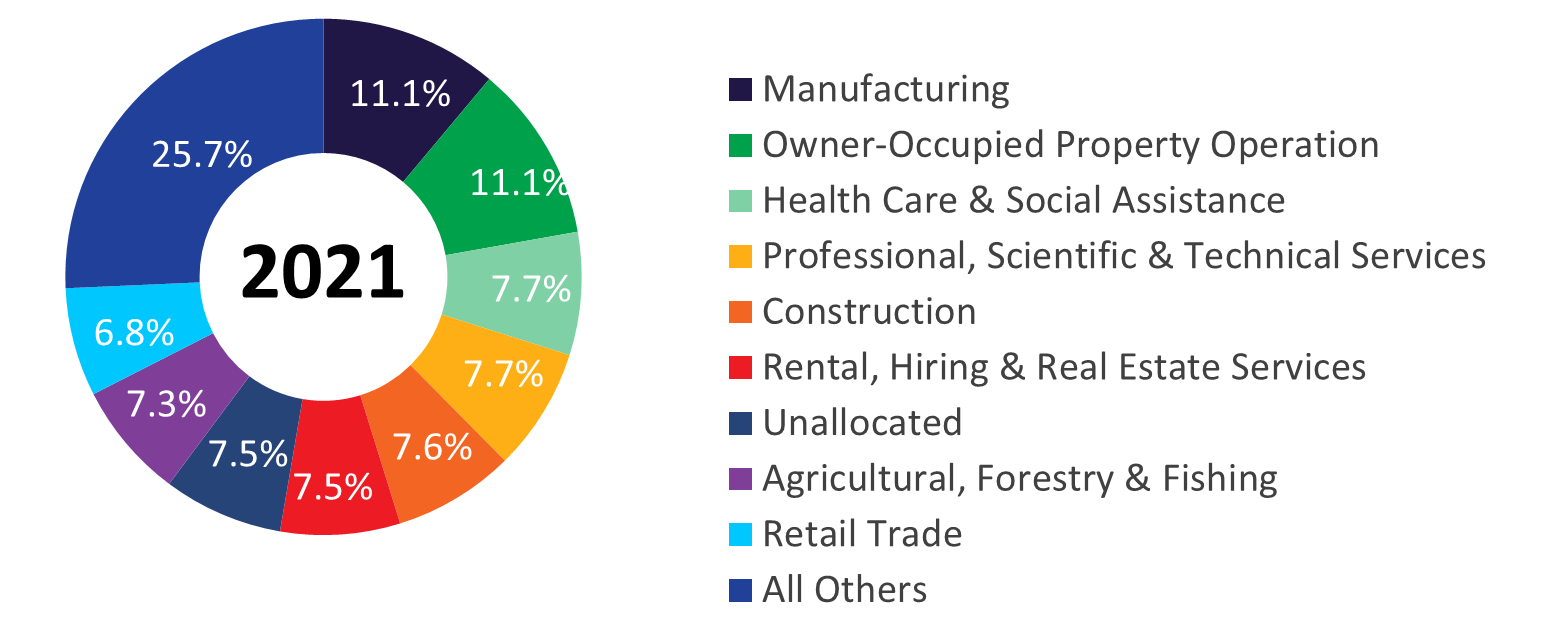
Text description of graph
Biggest contributions to economic growth, 2011 to 2021
| Total increase in GDP | $1,231m |
| Professional, Scientific & Technical Services | $133m |
| Retail Trade | $130m |
| Construction | $119m |
| Manufacturing | $118m |
| Agriculture, Forestry and Fishing | $100m |
| All other industries | $631m |
Proportion of filled jobs
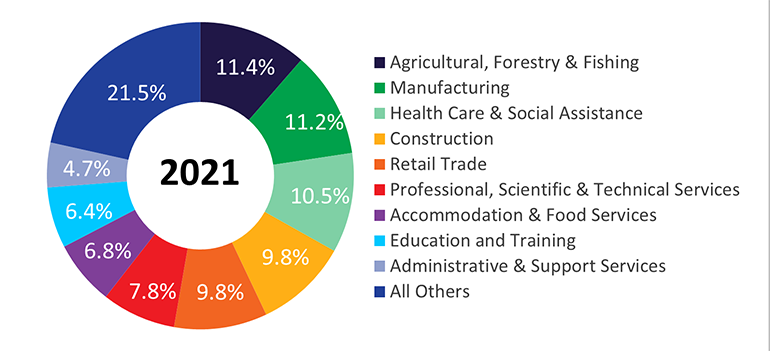
Text description of graph
Industries which created the most jobs, 2011 to 2021
| Total increase in employment | 8,599 |
| Construction | 1,417 |
| Manufacturing | 1,053 |
| Professional, Scientific & Technical Services | 1,004 |
| Health Care and Social Assistance | 943 |
| Accommodation and Food Services | 624 |
| All other industries | 3,558 |
Unemployment is low, but some groups are not well represented in the workforce
Our region does not get regular and accurate data on labour market participation, due to issues in national statistical reporting. For example, the national Household Labour Force Survey combines Nelson and Tasman data with the West Coast and Marlborough regions, resulting in data that is not specific to our region. However, we do know that Nelson Tasman has relatively low levels of unemployment; that employers find it difficult to recruit staff across all skill levels; and that we have a 9.9% NEET rate – youth who are not in employment, education, or training (Infometrics Annual Economic Profile, original source Stats NZ Household Labour Force Survey).
(external link)Our workforce faces several challenges
We know Nelson Tasman is rich in potential, and has the resources and talent for a prosperous and successful future. However, we also know our productivity is extremely low, our wages are lower than the rest of New Zealand, and our housing affordability and supply is at crisis level. These challenges have significant impacts on our region’s workforce and on our ability to attract workers from elsewhere.
Nelson Tasman: The Talent Challenge - August 2020 [PDF 1.7MB](external link)
Lower skills and qualifications may worsen outcomes for our people
Nelson Tasman has a slightly lower qualification profile than the New Zealand average. Just over 50% of the Nelson Tasman population has either no qualifications or has Level 3 as their highest qualification.[9](external link) This is also reflected in the disproportionally low NCEA achievement rates of Nelson Tasman Māori, as identified in the rangatahi section of this regional workforce plan.
Whilst a qualification is not essential for success, research by the Tertiary Education Commission indicates that people with less than a Level 4 qualification are more vulnerable to negative impacts of labour market changes, and more likely to experience financial hardship, unemployment, and poorer life outcomes.
Low productivity impacts our region’s businesses as well as our workforce
Our region’s productivity has been low for a long time. However, it has only been brought to the forefront recently, with our Nelson Regional Development Agency making it an intensive focus in the last year.
Growth in productivity: Nelson-Tasman 2021(external link) — Infometrics
Our region’s productivity is $1.67 billion below the national average, and GDP per person is $97,000 per year, 22% lower than the national rate of $125,000. Based on current patterns, we’ll take up to 145 years to catch up. This has significant impacts on our region’s workforce, as low productivity negatively impacts companies’ profitability and their ability to pay higher wages (Nelson Tasman Economic Briefing prepared for the NRDA by Benje Patterson, People and Places, February 2022).
As a region with many small to medium enterprises (SMEs) and self-employed workers, we do not have extensive regional workforce planning driven by large sector or industry groups. Taking a collective approach to workforce planning for our region includes working with the industry collective approach provided by the WDCs. This approach creates an opportunity to address some of the skills and labour issues impacting our productivity, as well as increasing opportunities for new roles for our workforce.
Low wages and high house prices impact affordability and attraction
Low wages and high house prices impact our region’s affordability, our people’s wellbeing, and the ability to attract and retain talent.
Average wage earnings in our region are the second lowest in New Zealand, being $57,476 compared to the national average of $65,910 (Nelson Tasman Economic Briefing prepared for the NRDA by Benje Patterson, People and Places, February 2022).
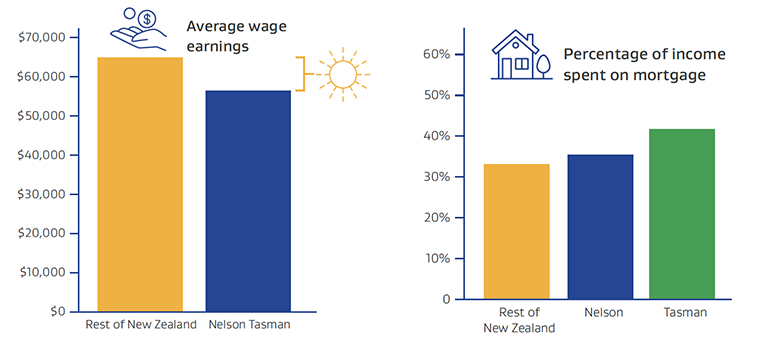
Text description of graphs
In addition to lower wages, Nelson Tasman is the third to last in affordability for buying or renting a home in New Zealand (where affordability is the average house price divided by the average household income). Nelsonians spend an average of 36% of their income on their mortgage, and people in Tasman spend 41%, compared to the national average of 34% (Nelson Tasman Economic Briefing prepared for the NRDA by Benje Patterson, People and Places, February 2022).
COVID-19 has impacted our communities and industries
COVID-19 has had both positive and negative impacts on our communities.
Many of our people and families have faced loss of income, due to falling ill, isolation requirements, or having reduced work. Iwi and social agencies have reported a significant increase in the numbers of whānau struggling to provide for basic needs, which is being exacerbated by rising inflation.
Industries with a high reliance on migrant labour and on international visitors have been the most negatively impacted, specifically horticulture, hospitality, and tourism. COVID-19 has highlighted the long-standing issue of our limited local labour supply. To support our communities and industries to thrive post COVID-19, one of our key aspirations is to reduce our reliance on low-paid migrant labour.
Our businesses and employers have also struggled with a lack of flexible business models, which has impacted their ability to attract and retain workers in a changing work environment due to COVID-19. Some employers have responded to this challenge by rethinking their business models and work practices. We have heard many stories from businesses of innovations they have introduced to attract and retain staff. Examples are amending shifts to reflect school hours, enabling caregivers to work, and taking other ‘job-shaping’ actions, such as splitting a 12-hour shift into two 6-hour shifts, to make the role more appealing and to allow for job-sharing between two workers.
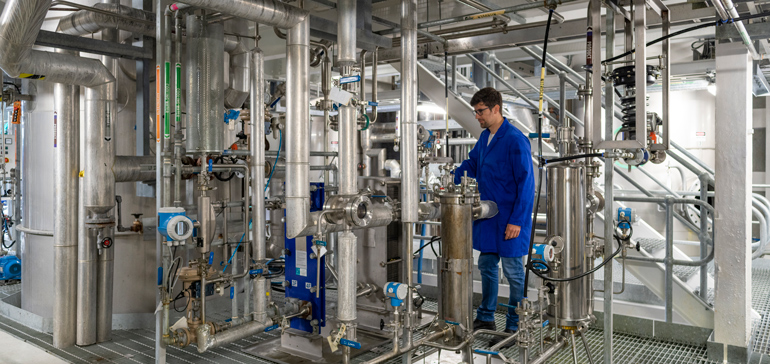
Photo credit: Nelsontasman.nz
Our future and our future workforce
Our future economy will be impacted by global megatrends, particularly technology, climate, and demographic changes.
Based on current estimates, our population growth is unlikely to meet the needs of our regional workforce.
By 2033, our region’s population is projected to increase by about 15,000 people. Over the same period the number of filled jobs in our region is projected to increase by about 10,000 so we are likely to have more jobs than people of working age to fill them.
The makeup of that future population will be more diverse. Māori, Pacifica, and Asian populations will grow, especially youth. In addition, we will have more older people, with people aged 65+ increasing from about 20% to about 30% of our population (Stats NZ Population estimates by regional council – High projections).
MBIE’s Chief Economist Donna Purdue has noted:
"Structural drivers of change, like ageing populations … have the potential to be even more disruptive than COVID. How we respond in the next few years will play a key role in shaping our future direction."
Due to our ageing population, and subsequent shrinking proportion of our working-age population (people aged 15-64), we need to look at ways to enable older people to remain in the workforce, if they want to do so. We’ve focused on enabling older workers as a priority group for this regional workforce plan.
This demographic change means we need to maximise the skills and innovation potential of our rangatahi, ensuring that they are supported to know about career opportunities in our region and access them, whilst being enabled to progress their careers to ensure a good future for them and their wider whānau. We’ve focused on rangatahi as a priority group for this regional workforce plan.
An increase in jobs requiring skilled workers in the future
We know increased investment in technology and innovation will change the nature of work. Skills and training can drive our workforce in a direction that will assist innovation and allow our people and economy to thrive. We can proactively shape our future workforce to address wellbeing inequalities such as health, education, income, and housing,[13](external link) whilst ensuring decent work and supporting increased regional productivity.
The Te Tauihu intergenerational strategy(external link) — Tetauihu.nz
While we don’t know exactly what the future demands for skills will be, modelling predicts an increase in demand for highly skilled workers in all industry sectors in Nelson Tasman over the next five years (NMIT Employment Forecasts to 2025 – Marlborough and Nelson Tasman Regions, Infometrics, January 2021). This could mean a shift in the current workforce, as was described in community consultation, ‘to do less with our hands and more with our heads’.
To meet future demand, we need to make changes. We could do this by:
- upskilling our current workforce by developing the people we already have
- ensuring we actively develop both our up-and-coming workforce (those still at school), and those who are looking to change careers or wanting more work, by growing understanding and awareness of careers in our region and their training opportunities and career pathways
- looking for opportunities to better collaborate with local polytechnics and universities, supporting them to develop and deliver a curriculum that meets the needs of our workers, as well as our industries and employers
- bringing people into our region to fill roles we can’t fill locally.
Climate change will also drive demand for new skills
Our region is vulnerable to rising sea levels, and biodiversity is declining as a result of pollution, invasive species, and changes in how we use the land and sea. What can grow where will change over time and we will need to adapt to more extreme weather events that happen more often. Internationally, economies will demand a wider, different range of products that are environmentally sustainable across the whole supply chain. Globally, non-renewable resources are becoming exhausted, and there is a clear focus on seafood, particularly aquaculture, as a growth area for its environmental and nutritional advantages over traditional land-based proteins.
The Nelson Tasman draft regeneration plan 2021 - 2031 (Project Kōkiri 2.0)(external link) — Project Kōkiri website
This represents opportunities for us to be nimble and claim the economic gains already appearing as consumers and governments change what they value. Our region’s horticulture, forestry, and oceans economy (aquaculture and seafood) sectors have been resilient through the COVID-19 pandemic. With good stewardship, and the right workforce skills and development, we are well aligned to contribute to the increasing global demand for food and fibre products that can be produced sustainably.
We will need to seek ‘just transitions’ for working people who will need to be trained, reskilled and/or redeployed due to climate pressures. Industrial transition to working in a low carbon context will be integral to meeting our economic, social, and cultural aspirations as a region.
Upskilling and attracting workers
The Nelson Tasman labour market has great potential to improve training opportunities and the way we work. By enabling change, we’ll help our economy to become more productive and will ultimately support our workforce to respond to changing demands for labour and skills.
- Provide training and development opportunities – Ensure workers of all ages can get the skills they need to grow and adapt to a modern workplace, such as developing soft skills, learning new technology, and resilience strategies.
- Influence training and education – Advise TEC and Te Pukenga, as part of our ability to influence training and education in communities and businesses.
- Attract and retain rangatahi – Identify development and training opportunities, and pathways for career progression, to ensure our rangatahi have fulfilling work.
Continuing to support our growing industries and businesses
- Construction industry – This industry has seen strong growth, with a 2.2% increase in the number of filled jobs between 2011 and 2021. Job creation will increase with major infrastructure developments in the next five years, such as the Nelson Hospital Redevelopment.
- Māori business and economy – There are many Māori-owned businesses and self-employed Māori across the Te Tauihu rohe (encompassing Nelson Tasman and neighbouring Marlborough). Research by Te Puni Kokiri has identified the most common industries for Māori owned businesses and retail and construction in Tasman and professional scientific and technical services as well as construction in Nelson. Te Tauihu’s eight iwi have net assets of about $800 million.
- Primary industries – The oceans economy, forestry, and horticulture have grown significantly over the past decade. The national oceans economy is projected to double by 2035.
Te Matapaeroa 2019 [PDF 883KB](external link)
Being open to new ways of working
- Support and encourage flexible working environments – COVID-19 has highlighted the benefits of flexible work environments and business models in improving both wellbeing outcomes for people, and resilience and productivity for our local businesses, through the use of technology. Flexible work environments not only attract workers, but also retain workers (for example, older workers who wish to continue to work but reduce hours in transitioning to retirement).
- Widening recruitment to get the right talent into jobs – Flexible working can attract a wider range of talent and encourage more people to enter the labour market. However, a wider pool of applicants still needs to be reached to fill jobs with the right talent.

